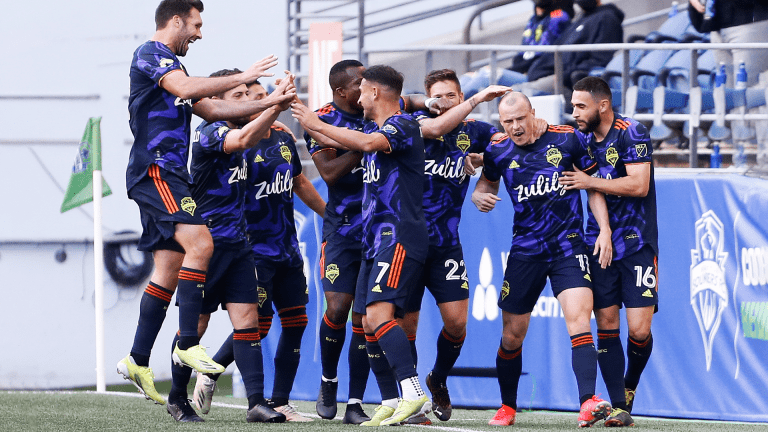It feels a little strange, doesn’t it?
We’ve grown so accustomed to seeing the Seattle Sounders play out of a 4-2-3-1 formation that it seems wrong for them to use a different positional alignment. Brian Schmetzer has leaned hard on the 4-2-3-1 since taking over as the Sounders head coach midway through the 2016 season. It was his primary formation that year, then again in 2017, then again in 2018, and 2019, and…well, you get the idea.
But things are different in 2021. Without Jordan Morris’ goalscoring and shot-creating ability on the left wing, Schmetzer decided to change things up.
“We are just trying to figure out what works out on the grass,” Schmetzer noted back in preseason. “It’s a work in progress still, but we definitely want to utilize Will \[Bruin\], Raul \[Ruidiaz\] and Fredy \[Montero\] because with the loss of Jordan, we have to make sure we pick up some goals there.”
Just three weeks into the regular season, the “work in progress” that Schmetzer referenced has become an extremely potent, miserable-to-play-against 3-4-1-2.
After three games, Seattle sit atop of the Supporters’ Shield rankings with seven points and a plus-seven goal difference. First, it was the 4-0 win over Minnesota United FC on opening weekend. Then it was a 1-1 draw at Bob Bradley’s LAFC. Then it was 3-0 win against Chicharito and the LA Galaxy.
So, how have they adjusted to their new shape so quickly? Well, despite the formation change, one major, overarching principle has remained constant from last year to this year: Schmetzer is still setting up his team in a way that puts his players in positions to succeed.

Ruidiaz, with Bruin next to him and Cristian Roldan underneath him in the attack, is still getting shooting opportunities in good spots (Ruidiaz is sixth in MLS in terms of average shot quality, with 0.169 xG per shot per Second Spectrum) and scoring goals (he’s second in MLS in goals so far this year with four). Wingbacks Alex Roldan and Brad Smith are allowed to bomb up their respective sidelines like Seattle’s fullbacks have done in the past. And instead of dropping one of his central midfielders into the backline, Schmetzer just has an extra center back, which allows the outside defenders to push high and wide. Roldan and Smith are putting that attacking freedom to good use; they’re both among the top 15 fullbacks/wingbacks in MLS in terms of passes that lead to shots.
Ruidiaz, Alex Roldan and Smith are just three examples of players who Schmetzer is using in logical spaces on the field. You can also put Nouhou, who has transitioned from left back to center back by using his speed to pressure opposing forwards, Cristian Roldan, who is playing as a central attacking midfielder with freedom to rotate out wide, and pretty much every other Seattle player on that list as well.
The Sounders’ coaching staff is so good at the most important part of coaching: they put their players in positions to succeed. Some of those literal, on-field positions have changed from 2020 to 2021, but Seattle’s tactical approach and formation choice are just as logical this year as they’ve been in years past. Despite that macro similarity, there are notable differences between how the Sounders’ are playing out of their 3-4-1-2 and how they played last year in their 4-2-3-1.
This year, Seattle are applying more aggressive pressure on the ball. In 2020, Seattle averaged 253 pressures per 90 minutes. So far in 2021, they are averaging 312 pressures per 90 minutes. The Sounders aren’t pressing more in the final third (they averaged 51.4 final-third pressures per 90 minutes last year compared to 50.6 this year), but they’re forcing more turnovers in those areas. In 2021, Seattle have forced a turnover within five seconds on 45.6% of their pressures in the final third. That’s a nearly 5% increase from their 40.9% last season.
In possession, Seattle are also attempting fewer crosses (12.9 crosses per 100 possessions this year compared to 19.7 last year) and generally attempting fewer passes. Their passes attempted per game is down from 545 to 480, which could be an intentional shift from Schmetzer and Co. or (more likely) boils down to game states. Seattle have only trailed for 52 minutes this season, which means that they haven’t needed to control the ball and string together attacks to salvage a result.
Looking ahead to Week 4, Nicolas Lodeiro could be in line for his first start of the season in Seattle's visit to the Portland Timbers on Sunday (3 pm ET | ABC, ESPN Deportes). Based on his substitute appearance against the Galaxy, where he came on for Bruin in the 66th minute, Lodeiro may tweak Schmetzer’s positioning if he starts against Portland.
Lodeiro played a free attacking midfield role on Sunday and shifted Seattle’s 3-4-1-2 shape into more of a 3-4-2-1. Schmetzer may opt for the 3-4-2-1 against Portland or he might shift Cristian Roldan deeper into midfield next to Joao Paulo and use Lodeiro as the 10 in the 3-4-1-2. Either alignment would suit Seattle’s desire to push their wingbacks high up the field in possession, create shots for Ruidiaz and pressure the ball defensively.
The foundation of Seattle’s formation has changed, but Schmetzer’s ability to create a logical and effective tactical approach that puts his players in positions to succeed has not. Seattle’s three-at-the-back era is off to a great start – and it’s only the beginning.












